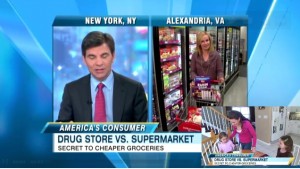All week I will be sharing my favorite money saving articles with you!
To maximize your grocery dollar, you should stock up when an item is at its rock-bottom price. By buying enough to last you until the next sale, you will guarantee that you won’t have to pay full price again. But how do you know when an item is at its rock-bottom price, and how do you know when the next sale will be?
Unfortunately, there’s no simple answer to those questions. A good price for the item in question depends on many factors. Prices vary from store to store, from region to region and from seasons to season. Learning to determine rock bottom prices takes time.
Calculating Unit Price
Calculating the unit price is an essential skill to master if you’re going to make any progress in cutting your grocery bill. You won’t know if the big box of Cheerios that is on sale is a better deal than the small box of generic cereal unless you can calculate the per ounce cost. Fortunately, calculating the unit price is pretty simple.
First ask yourself what you’re trying to figure out. If you want to know the cost per ounce ($/oz) you will simply divide the cost of the item by the number of ounces. That’s it. This applies to any unit of measurement: take the total cost of the item and divide by the unit or the number or items and you’ll figure out the unit price.
Creating a Price Book
A price book is basically a record of the prices of products you buy. For example, if you are interested in learning the best price of canned diced tomatoes, make a record of the price every time you go to the store and eventually you will see the item go on sale. If you keep at it long enough, eventually you will have a record of how often each item you buy goes on sale and what its rock-bottom price is.
To be quite honest, I found keeping a price book to be too much work although I do think it is the best way to be assured you’re getting the lowest price. Instead, my method is much simpler. When I first began couponing, I picked five or so items I buy frequently and learned their regular prices. When they went on sale, I made a note of the price in a simple spreadsheet on my computer. If I had a coupon, I recorded the price after the coupon in my spreadsheet. By keeping this simple record, I was able to set target prices for the items I buy regularly, and I expanded my list to include more items. Now I store my target prices in my head, and I only have to reference my spreadsheet for items I don’t buy routinely. The disadvantage of this system is that I don’t know the best price for every item I buy. In those cases, I shoot for 50% off or more. If after a sale and coupon an item is 50% of its regular price, I think it’s a pretty safe bet that I’m getting a good deal.
Some items, like cereal, go on sale regularly while others hit their rock bottom price only once a year. For example, during the summer months, items for grilling like ketchup, charcoal and barbeque sauce reach their lowest price for the year. If that’s the case, I buy as many as I can use before the expiration date, if the budget allows.
Keep tabs on all the hottest deals by subscribing to our FREE daily newsletter and follow us on Facebook! Looking for more coupons? Check out our Coupon Database or visit Coupons.com, Red Plum and Coupon Network! This post may contain affiliate links.


